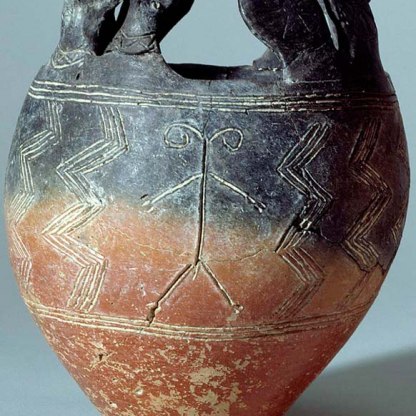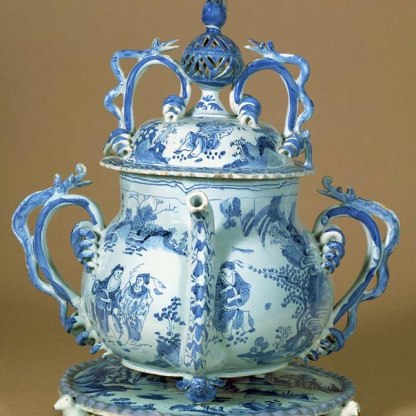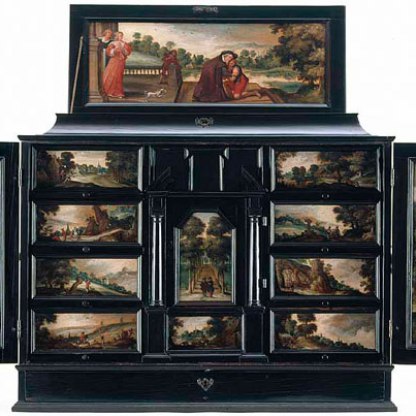Iznik Jug

The main body of this jug was made in the sixteenth century in Iznik, Turkey, a town renowned since the fifteenth century for its decorated ceramic vessels and tiles. It owes its finished appearance, however, to the English goldsmith who in 1592 made the fittings on the lid handle and base and signed them ‘I.H.’.
The stylised decoration of red hyacinths and turquoise pomegranates, standing out against a clean, bright, white background, is typical of sixteenth-century Iznik ware. The brilliant colours were the innovation of Turkish artists who had previously imitated the blue-on-white decoration of Chinese porcelain.
The Islamic viewer may well have seen in the stylised vegetation an evocation of the miracle of Allah’s creation of the natural world. Certainly Iznik tiles with floral decoration, such as that left [C.1-1929], were, and still are, made to decorate the interiors of mosques. It is doubtful, however, that the response of the Elizabethan owner of this jug was as elevated. For him it was a luxury item, its beauty material rather than spiritual. From the addition of a hinged lid, it seems that the vessel was used as a beer flagon.
British attitudes to Turks were ambivalent in the sixteenth and seventeenth centuries. As contact between the Ottoman Empire and England increased, the Turk became a common and stereotypically villainous figure on the British stage. A reference in Shakespeare’s Othello to a 'malignant and turban’d Turk ... the circumcis’d dog', is typically abusive. The attitude was based upon the long-standing antipathy between the Islamic East and the Christian West.
Yet there was clearly also admiration for Near Eastern material culture. In early 1582, diplomacy between the courts of Elizabeth I and the Ottoman Sultan Murad III led to the founding of the Turkish Company – later called the Levant Company – which facilitated trade between Turkey and England. Luxury goods such as this jug could now be freely imported to London. In 1570 a licence was granted to four Englishmen to produce 'earthen vessels and other earthen works with colours ... after the manner of the Turks'.
The addition of the silver-gilt mounts suggests the esteem in which such objects were held. As well as further enriching an already valuable object, the mounts help protect the fragile edges from chipping. A nautilus shell cup in the Fitzwilliam, left [MP.4-1938], is another exotic Eastern item that has been beautified and protected in this way.
Themes and periods
Data from our collections database
Fritware, wheel thrown, painted red slip, blue green and black under a colourless, slightly pitted glaze Shape: pear shaped body with a cylindrical slightly flaring neck, sits on a low foot ring. A strap handle is attached just below the rim and on the shoulder, covered on the exterior with a sliver gilt mount. Circular silver gilt mount on the base, a circular hinged lid on the rim is mounted with a finial and with a thumb rest; a strip is mounted on the handle running down to the base. Exterior: three linear friezes on below the rim, on the shoulder and on the lower body comprise respectively black scalloped lines, black dashed lines with underlying blue lappets and roughly drawn black crenulations. These friezes enclose a pattern of blue pomegranates and scrolling red hyacinths that dominate the neck and body. Glaze covers the surface including the underside of the foot ring. The mounts are cast and engraved, with lappets on the base, reeded with a serrated edge on the handle, with lions’ masks and fruit on the lid and with a winged figure on the thumb rest. Interior: Glazed but otherwise undecorated.
Possibly Elizabeth Tollemache, Duchess of Lauderdale; Dysart Collection, Ham House, Richmond; C.L.N. Tollemache; sold Christie's, 26 July 1948, Catalogue of Old English Silver, The Property of C.L.N. Tollemache Esq., Ham House, Richmond, Surrey, p. 17, lot 135, illustrated as frontispiece
Legal notes
Purchased with the Leverton Harris Fund, and from the bequest of Albert Leopold Reckitt
Acquisition and important dates
- Method of acquisition: Bought
- Dates: 1948-11-18
Dating
John (Jan) Hoffman was an immigrant goldsmith from Bamberg, who was denizised in 1577. He was a member of the Dutch Church in London. He was last recorded in 1599 and his date of death is unknown.
Label text from the exhibition ‘Feast and Fast: The Art of Food in Europe, 1500–1800’, on display at The Fitzwilliam Museum from 26 November 2019 until 31 August 2020: Together with the hyacinth, the pomegranate became a common decorative motif on later sixteenth-century polychrome tableware made in Ottoman Anatolia, as seen in this Iznik jug. It was likely made and exported to Elizabethan London shortly before 1592, when the fashionable silver-gilt mounts were added to protect its fragile edges and render it even more luxurious.
Maker(s)
- Unidentified Iznik pottery Potter
- Possibly Hoffman, John (Jan) Goldsmith
Note
John (Jan) Hoffman was an immigrant goldsmith from Bamberg, who was denizised in 1577. He was a member of the Dutch Church in London. He was last recorded in 1599 and his date of death is unknown.
Label text from the exhibition ‘Feast and Fast: The Art of Food in Europe, 1500–1800’, on display at The Fitzwilliam Museum from 26 November 2019 until 31 August 2020: Together with the hyacinth, the pomegranate became a common decorative motif on later sixteenth-century polychrome tableware made in Ottoman Anatolia, as seen in this Iznik jug. It was likely made and exported to Elizabethan London shortly before 1592, when the fashionable silver-gilt mounts were added to protect its fragile edges and render it even more luxurious.
Place(s) associated
- Iznik
- London
Materials used in production
Read more about this record3D scan
Accessibility Notice:
The 3D model on this page is hosted on Sketchfab and may not be fully accessible to everyone, including users of assistive technologies. We apologize for any inconvenience.
Other highlight objects you might like
Suggested Curating Cambridge products
Sign up to our emails
Be the first to hear about our news, exhibitions, events and more…





